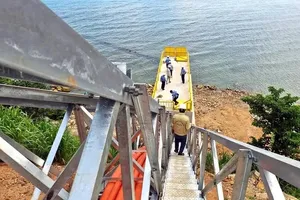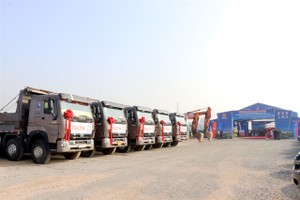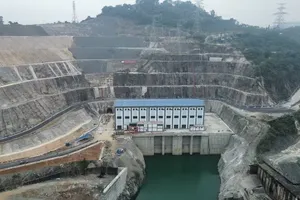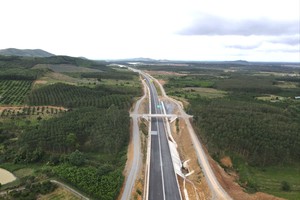The ongoing severe drought and saltwater intrusion will continue affect badly to livelihood and daily life activities of farmers of provinces in the Mekong Delta this year.
.jpg)
According to the Ministry of Agriculture and Rural Development, the Mekong Delta, the country's largest supplier of rice, fruit and fisheries, is facing the worst drought and saltwater intrusion in 90 years which has sent tens of thousands of local households into misery. However, by now it is not yet the peak of the dry season.
Among the provinces in the Mekong Delta, Kien Giang Province possesses the largest area of rice has been deceased by drought and saltwater intrusion. Local farmers are rushing for taking measures to tackle with drought and saltwater intrusion. Mrs. Huynh Thi Kip, a farmer in Binh Giang Commune in Hon Dat District, said that her family has been living here for nearly 30 years but she has never experienced such an extreme weather. This winter-spring cultivation, her family grew rice in an area of 8 hectares. As well as other households, her family pumped water from Canal 4 into their rice fields. However, they did not recognize that saltwater had already intruded into the Canal 4. Just two weeks later, more than 70 percent of her 8 hectares was damaged, losing VND150 million of initial investment capital.
Mr. Danh Giang, a farmer in Binh Giang Commune, said bitterly that saltwater unexpectedly intruded deeply into fresh water aquifers but none of them was aware of the problem. For any household that pumps water into their rice fields, it will end up totally lost. On average, farmers have lost VND20-30 million per hectare.
Mr. Nguyen Van Phat, vice chairman of the People’s Committee of Binh Giang Commune, said that latest figures show that nearly 1,000 hectares of winter-spring cultivation were affected by drought and saltwater intrusion, primarily due to the saltwater rises in begin of February. In addition, farmers and local authorities did not expect such a high level of saltwater, therefore, they were unable to deal with the situation. As the situation is getting worse, the damage's sum is expected extend to higher.
In Kien Giang Province’s Vinh Thuan District, drought and saline intrusion also take damage toll on a huge area of rice cultivation. According to the People’s Committee of Dong Phong Commune in Vinh Thuan District, local farmers cultivated rice in an area of more than 950 hectares this winter-spring cultivation. When rice got more than one month old, drought and saltwater intrusion hit rice fields, and deceased rice in large scale. Some households tried grow rice again for two or even three times; however, with saltwater surrounding them, rice plants were unable to persist.
In districts as An Minh, An Bien, Go Quao, and U Minh Thuong, the area of rice were deceased because of saltwater increased more. Leaders of the Department of Agriculture and Rural Development of An Bien District said that around 7,600 hectares of one-month-old rice cultivation were lost because farmers could not have initiative measures in getting fresh water.
Surrounding by water on its three sides, Ca Mau Province has seen destructive influence of intruding saltwater. In Tran Van Thoi District, rice fields were dry as of many weeks of drought. The water level was left in Duong Ranh Canal in Khanh Binh Commune just a few dozen centimeters high that caused several canoes to run aground.
Duong Hoang Lil, a local farmer, said that drought hit much earlier in this year. During the same time of previous years, canoes carrying rice could still move easily on the canal. Mr. Lil was pumping water from the canal into his fishpond at the moment, took advantage of the remaining quantity of water to save his fishpond as he expected there will be no more water in time of two weeks. There were a few parts along the Duong Ranh Canal, where water had already run so dry that people could walk across it without getting stuck.
Meanwhile, in Bac Lieu Province, winter-spring rice fields have run out of fresh water while saltwater exists everywhere. Mr. Nguyen Van Ky, an elderly farmer in Vinh Phu Dong Commune, Phuoc Long District, said that more than his one hectare of rice cultivation was thirsty for fresh water. Meanwhile, saltwater level out there in the flood control dam which isolates saltwater from fresh water was at around 1 meter higher than that in rice fields. Moreover, source of fresh water from Hau River through Quan Lo – Phung Hiep was also severely decreasing. Therefore, a serious shortage of fresh water at the end of rice crop is unavoidable.
However, Bac Lieu Province is caught in a real dilemma, if the saltwater will reduce in here, there will be risk of lacking saltwater for shrimp farming on an area of 67,000 hectares. On the other hand, if they supply enough saltwater for shrimp farming then rice cultivation areas in Soc Trang and Bac Lieu provinces will be affected.
.jpg)
In Soc Trang Province, productivity of rice and sugarcanes was also threatened by drought and saline intrusion. More than 10,000 hectares of rice were damaged, 689 hectares were completely lost, and more than 1,800 hectares were affected to an extend of 30 to 70 percent. As it is now beginning peak of the dry season, the salinity continues to surge, then protecting of harvest becomes extremely urgent.
Vinh Long Province has just experienced the worst saline intrusion with the highest salinity of up to 9.6 per mille at drain Nang Am – Vung Liem. Saltwater has affected farming and daily life activities of local people. The water is too salty for cooking or making tea. This situation has never been encountered here before; local people have never been concerned about a shortage of fresh water. Reports by agriculture departments of Vung Liem, Mang Thit and Tra On districts said that saltwater has affected a large area of rice cultivation. Thus, some districts had to close drains to keep fresh water. However, closing drains will cause a shortage of water and this in turn possibly reduces rice yield.
Saltwater surrounds the lower course of Tien River
Vinh Long Province has just experienced the worst saline intrusion with the highest salinity of up to 9.6 per mille at drain Nang Am – Vung Liem. Saltwater has affected farming and daily life activities of local people. The water is too salty for cooking or making tea. This situation has never been encountered here before, local people have never been concerned about a shortage of fresh water. Reports by agriculture departments of Vung Liem, Mang Thit and Tra On districts said that saltwater has affected a large area of rice cultivation. Thus, some districts had to close drains to keep fresh water. However, closing drains will cause a shortage of water and this in turn possibly reduces rice yield.
.jpg)
In the island province of Ben Tre, thousands hectares of winter-spring rice in Ba Tri District and other districts withered due to a shortage of fresh water. Drought and saltwater intrusion become more serious and has not showed any sign of ending. Mr. Nguyen Van Lam, a farmer in Vinh An Commune in Ba Tri District, said that his 2,000 square meters of rice were completely lost. Now he has no choice but turns rice plants into cattle feed.
More than half of the area of Tien Giang Province is directly affected by saltwater intrusion in dry season annually. This year, rice was grown in an area of 74,134 hectares, of which 30,000 hectares of rice were in the coastal district of Go Cong. As saltwater intrusion happens early this year, operation of water inlet sluices is seriously disturbed. For instance, salinity was now at 2 per mille at Vam Giong sewer that it had to be closed 20 days earlier than the same period last year. That of Xuan Hoa sewer was also above 1.5 per mille resulting in two months earlier in closing.
According to Mr. Tran Hoang Ba, deputy director of the Department of Agriculture and Rural Development of Tien Giang Province, most of the area of rice was already in ear. If water supply for watering is not improved as of March 5, there will be 7,000 hectares of rice lacking of water. And after March 15, if water source is exhausted, Tien Giang Province will lose 2,000 hectares of rice.
In Long An Province, Mr. Le Van Hoang, the provincial agriculture director, announced that salinity of 4 per mille has intruded 80 kilometers into Vam Co Dong River and 70 kilometers into Vam Co Tay River while salinity of 1 per mille has entered 105 kilometers into Vam Co Dong River and 115 kilometers into Vam Co Tay River. Because of that, the province has declared natural disaster emergency at northern districts, including Can Duoc, Can Giuoc, Tan Tri, Chau Thanh, Thu Thua, and Tan An City. In the province, there were nearly 3,500 hectares of rice hit by drought and saline intrusion, causing reduction in productivity and nearly 11,000 hectares of rice in Thu Thua, Tan Tru and Ben Luc districts were short of fresh water.
Since late February, saltwater may maintain at high levels. In Tien and Hau rivers, salinity of 4 per mille may intrude 50-70 kilometers deep into the river from the river mouth. Salinity will climb and last until early May. Saltwater not only affects production but also citizen lives, Mr. Hoang Duc Cuong, director of the National Center for Hydro-meteorological Forecasting, said.
























